Internet of Things Technology
VerifiedAdded on 2023/03/17
|11
|2627
|81
AI Summary
This article discusses the components and technologies of Internet of Things Technology (IoTT) and its applications in manufacturing and healthcare sectors. It also addresses the security issues and provides resolutions for them.
Contribute Materials
Your contribution can guide someone’s learning journey. Share your
documents today.
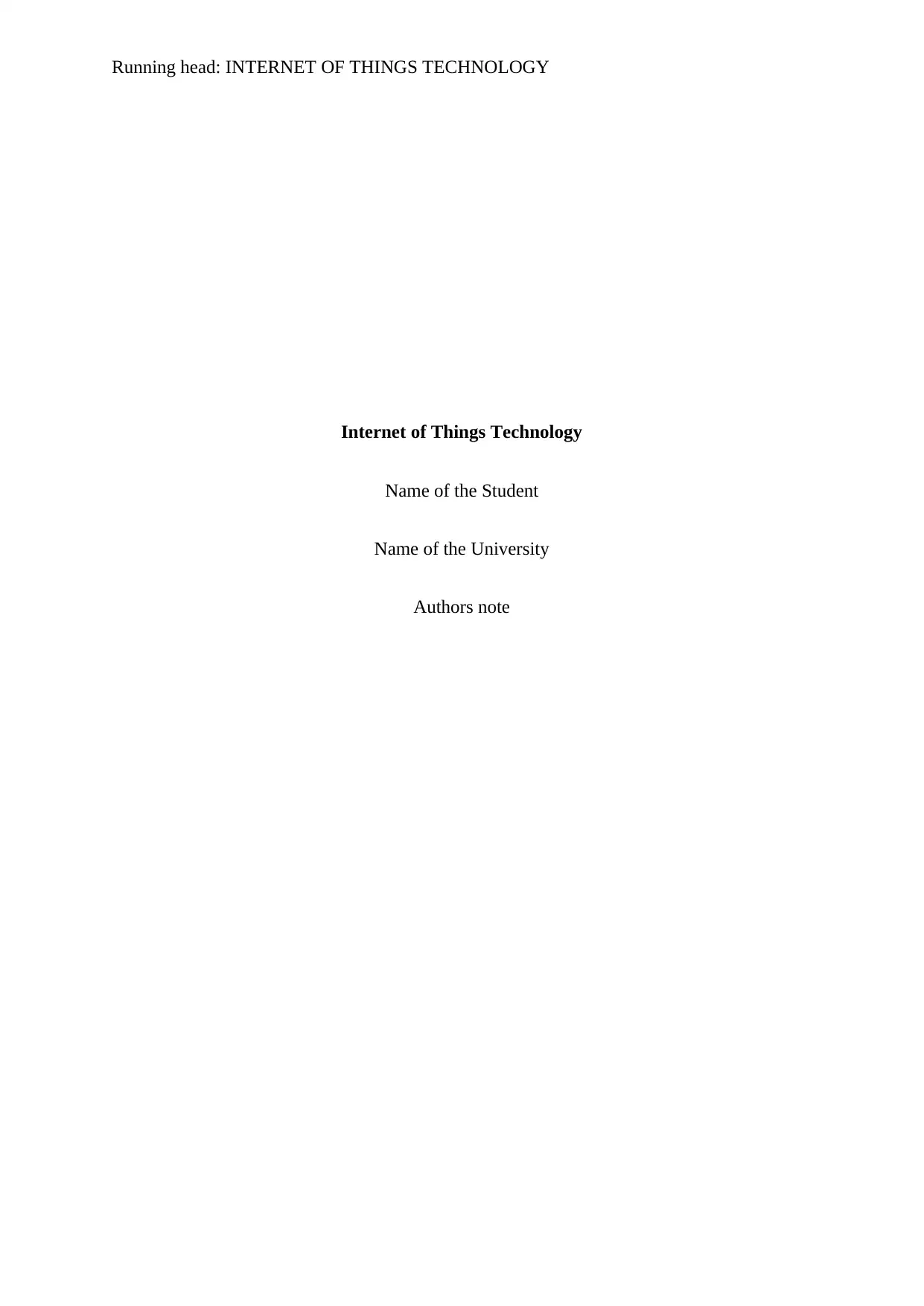
Running head: INTERNET OF THINGS TECHNOLOGY
Internet of Things Technology
Name of the Student
Name of the University
Authors note
Internet of Things Technology
Name of the Student
Name of the University
Authors note
Secure Best Marks with AI Grader
Need help grading? Try our AI Grader for instant feedback on your assignments.
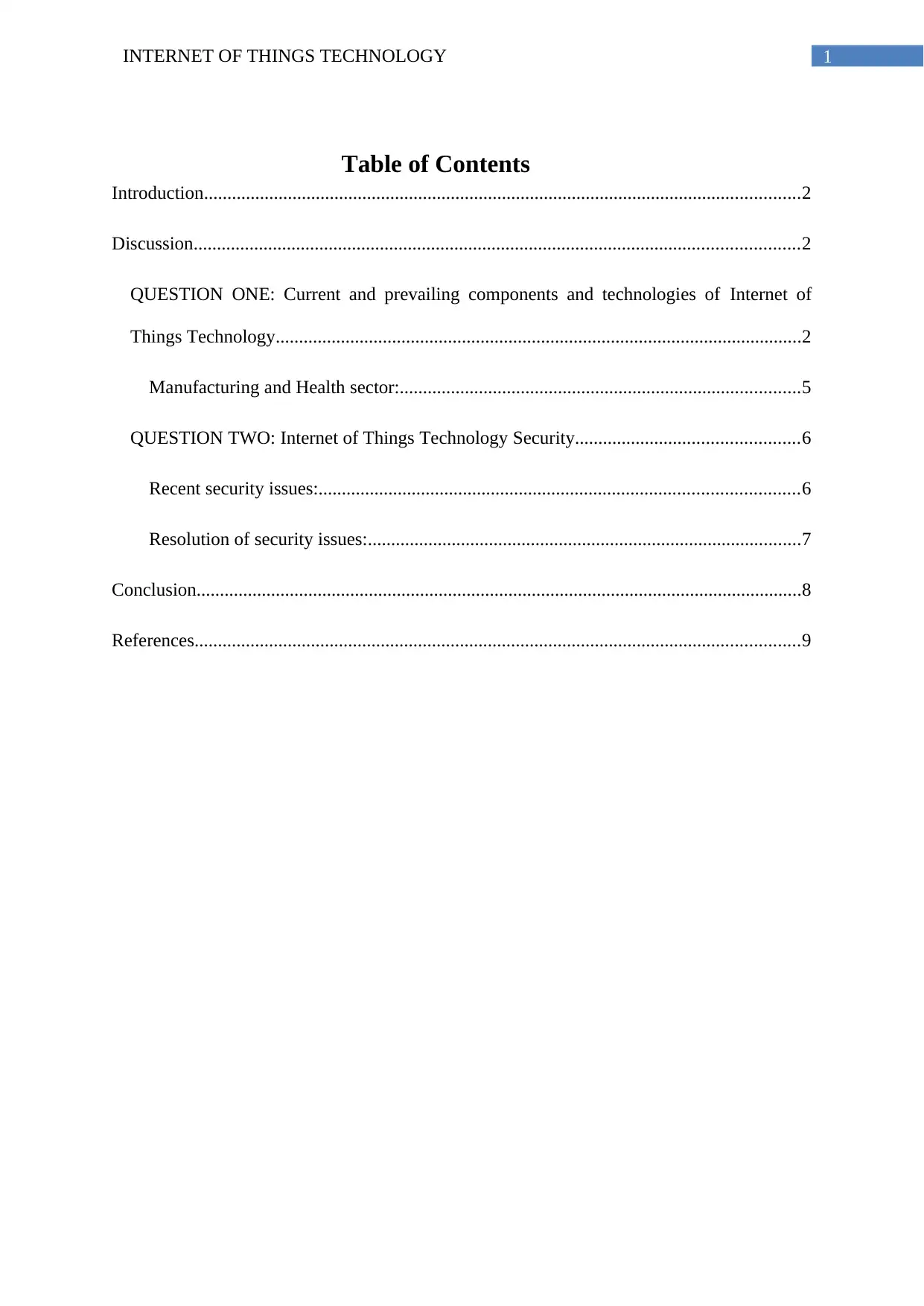
1INTERNET OF THINGS TECHNOLOGY
Table of Contents
Introduction................................................................................................................................2
Discussion..................................................................................................................................2
QUESTION ONE: Current and prevailing components and technologies of Internet of
Things Technology.................................................................................................................2
Manufacturing and Health sector:......................................................................................5
QUESTION TWO: Internet of Things Technology Security................................................6
Recent security issues:.......................................................................................................6
Resolution of security issues:.............................................................................................7
Conclusion..................................................................................................................................8
References..................................................................................................................................9
Table of Contents
Introduction................................................................................................................................2
Discussion..................................................................................................................................2
QUESTION ONE: Current and prevailing components and technologies of Internet of
Things Technology.................................................................................................................2
Manufacturing and Health sector:......................................................................................5
QUESTION TWO: Internet of Things Technology Security................................................6
Recent security issues:.......................................................................................................6
Resolution of security issues:.............................................................................................7
Conclusion..................................................................................................................................8
References..................................................................................................................................9

2INTERNET OF THINGS TECHNOLOGY
Introduction
Anything that is connected to internet can be termed as The Internet of Things
Technology (IoTT). It can be defined as a kind of network that can extend the internet
services into various other physical devices such as computers, machines object and even
animals. It offers a method that can help in data transmission over the internet. The idea of
IoT was originated from Radio Frequency Identification (RFID) by Kevin Ashton in 1999
(Al-Fuqaha et al., 2015). IoTT are devices that involves merging of multiple technologies and
embedded system. IOTT is a global infrastructure in the world of ICT that facilitate business
enterprises, economic society and human beings. “Things” in IoT suggests that it uses objects
or any physical thing that has the ability to be sensed and integrated into interactive network.
IoT makes use of environmental aspects to participate with the ICT technologies and internet
(Cui, 2016). This concept was implemented in order to make the world more advanced, a
world where every element has the ability to sense and share information. It not only
connects computers to the internet but any device, be it a vehicle or even a toy, all
interconnected with IP networks.
Discussion
QUESTION ONE: Current and prevailing components and technologies of
Internet of Things Technology
IOT combines two major technologies smart sensors and wireless connectivity with
microcontrollers. It is one the most used technologies recently. According to reports, 8.4
billion IoT devices has been used in year 2017 and it is estimated to cross over 20.4 billion by
2020 (Li, Da Xu & Zhao, 2015). The devices contains smart devices that are connected to
web that uses embedded processors and sensors. Hardware and soft wares are connected to
Introduction
Anything that is connected to internet can be termed as The Internet of Things
Technology (IoTT). It can be defined as a kind of network that can extend the internet
services into various other physical devices such as computers, machines object and even
animals. It offers a method that can help in data transmission over the internet. The idea of
IoT was originated from Radio Frequency Identification (RFID) by Kevin Ashton in 1999
(Al-Fuqaha et al., 2015). IoTT are devices that involves merging of multiple technologies and
embedded system. IOTT is a global infrastructure in the world of ICT that facilitate business
enterprises, economic society and human beings. “Things” in IoT suggests that it uses objects
or any physical thing that has the ability to be sensed and integrated into interactive network.
IoT makes use of environmental aspects to participate with the ICT technologies and internet
(Cui, 2016). This concept was implemented in order to make the world more advanced, a
world where every element has the ability to sense and share information. It not only
connects computers to the internet but any device, be it a vehicle or even a toy, all
interconnected with IP networks.
Discussion
QUESTION ONE: Current and prevailing components and technologies of
Internet of Things Technology
IOT combines two major technologies smart sensors and wireless connectivity with
microcontrollers. It is one the most used technologies recently. According to reports, 8.4
billion IoT devices has been used in year 2017 and it is estimated to cross over 20.4 billion by
2020 (Li, Da Xu & Zhao, 2015). The devices contains smart devices that are connected to
web that uses embedded processors and sensors. Hardware and soft wares are connected to
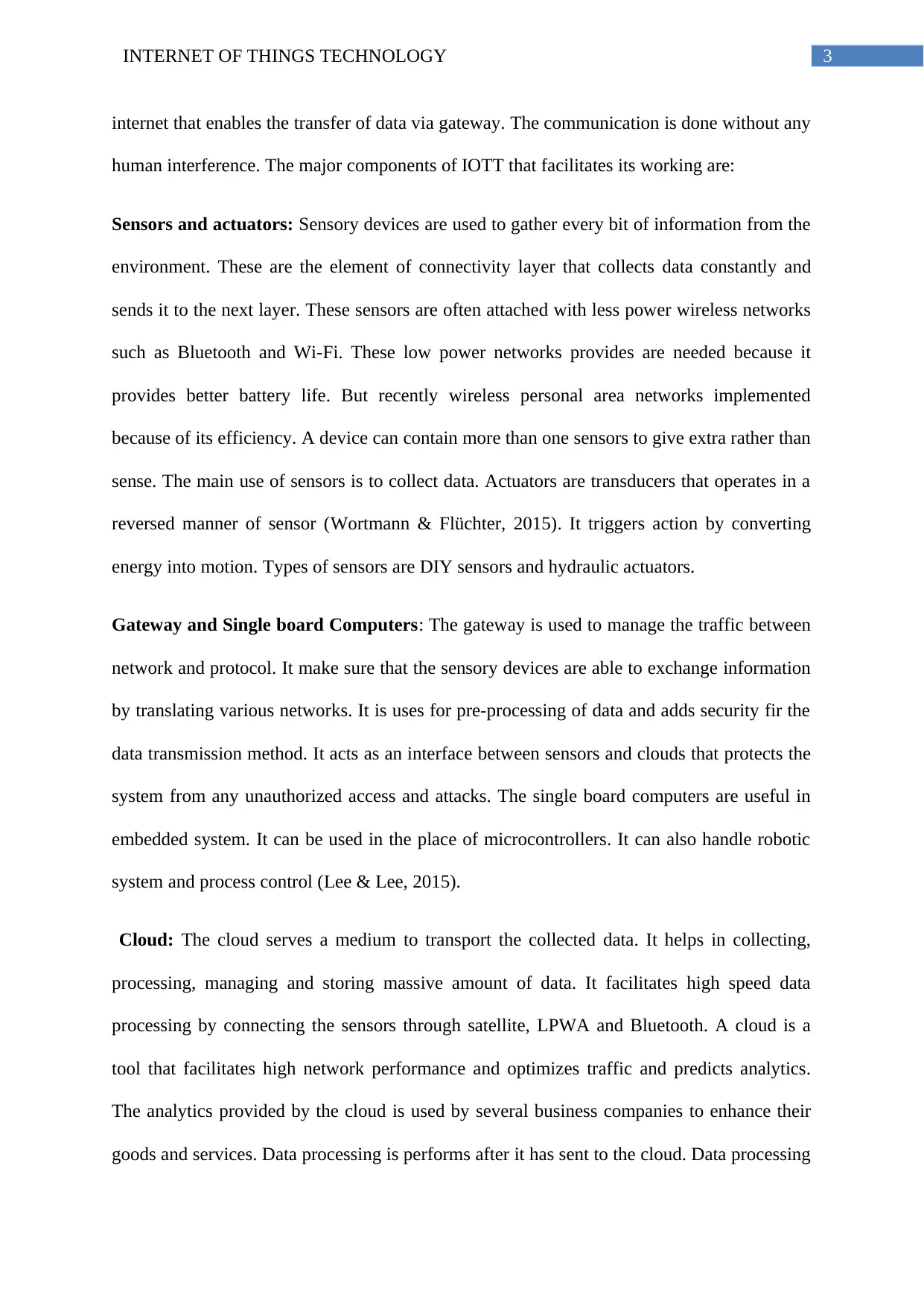
3INTERNET OF THINGS TECHNOLOGY
internet that enables the transfer of data via gateway. The communication is done without any
human interference. The major components of IOTT that facilitates its working are:
Sensors and actuators: Sensory devices are used to gather every bit of information from the
environment. These are the element of connectivity layer that collects data constantly and
sends it to the next layer. These sensors are often attached with less power wireless networks
such as Bluetooth and Wi-Fi. These low power networks provides are needed because it
provides better battery life. But recently wireless personal area networks implemented
because of its efficiency. A device can contain more than one sensors to give extra rather than
sense. The main use of sensors is to collect data. Actuators are transducers that operates in a
reversed manner of sensor (Wortmann & Flüchter, 2015). It triggers action by converting
energy into motion. Types of sensors are DIY sensors and hydraulic actuators.
Gateway and Single board Computers: The gateway is used to manage the traffic between
network and protocol. It make sure that the sensory devices are able to exchange information
by translating various networks. It is uses for pre-processing of data and adds security fir the
data transmission method. It acts as an interface between sensors and clouds that protects the
system from any unauthorized access and attacks. The single board computers are useful in
embedded system. It can be used in the place of microcontrollers. It can also handle robotic
system and process control (Lee & Lee, 2015).
Cloud: The cloud serves a medium to transport the collected data. It helps in collecting,
processing, managing and storing massive amount of data. It facilitates high speed data
processing by connecting the sensors through satellite, LPWA and Bluetooth. A cloud is a
tool that facilitates high network performance and optimizes traffic and predicts analytics.
The analytics provided by the cloud is used by several business companies to enhance their
goods and services. Data processing is performs after it has sent to the cloud. Data processing
internet that enables the transfer of data via gateway. The communication is done without any
human interference. The major components of IOTT that facilitates its working are:
Sensors and actuators: Sensory devices are used to gather every bit of information from the
environment. These are the element of connectivity layer that collects data constantly and
sends it to the next layer. These sensors are often attached with less power wireless networks
such as Bluetooth and Wi-Fi. These low power networks provides are needed because it
provides better battery life. But recently wireless personal area networks implemented
because of its efficiency. A device can contain more than one sensors to give extra rather than
sense. The main use of sensors is to collect data. Actuators are transducers that operates in a
reversed manner of sensor (Wortmann & Flüchter, 2015). It triggers action by converting
energy into motion. Types of sensors are DIY sensors and hydraulic actuators.
Gateway and Single board Computers: The gateway is used to manage the traffic between
network and protocol. It make sure that the sensory devices are able to exchange information
by translating various networks. It is uses for pre-processing of data and adds security fir the
data transmission method. It acts as an interface between sensors and clouds that protects the
system from any unauthorized access and attacks. The single board computers are useful in
embedded system. It can be used in the place of microcontrollers. It can also handle robotic
system and process control (Lee & Lee, 2015).
Cloud: The cloud serves a medium to transport the collected data. It helps in collecting,
processing, managing and storing massive amount of data. It facilitates high speed data
processing by connecting the sensors through satellite, LPWA and Bluetooth. A cloud is a
tool that facilitates high network performance and optimizes traffic and predicts analytics.
The analytics provided by the cloud is used by several business companies to enhance their
goods and services. Data processing is performs after it has sent to the cloud. Data processing
Secure Best Marks with AI Grader
Need help grading? Try our AI Grader for instant feedback on your assignments.

4INTERNET OF THINGS TECHNOLOGY
can be sometimes simple and sometimes complex. Like checking the temperature reading and
finding intruders inside the house using computer vision.
Analytics: Analytics is used to change the analog data into useful input that will be used for
further analysis. Smart analytics helps to detect any uncertainties or fault in the data which is
gathered by the sensors. It prevents any fault by correctively analytics of information.
Business enterprise uses data analytics to insights any future uncertainties and opportunities.
Predictive analysis helps to provide necessary information to the business in order to ensure
future success.
Interface: User interface are those area of IoT which is accessible by the user. A good
interface will serve as a tool to simplify any complex task. It allows the user to effortlessly
interact with the system and check in actively (Want et al., 2015). Better design of the
interface will facilitate the user and be more dependent on it. It can provide automated
services even in the absence of any human.
Current and Emerging IoT technologies are:
1. IoT platforms: it consists plenty of IoT devices into a single system. It is used for data
acquisition, application development and controlling the devices.
2. Event Stream processing: This technology exceptionally produces high data rates
which is done analysis based on real time (Sadeghi, Wachsmann & Waidner, 2015).
3. IoT Analytics: this technology is mainly used by business enterprises for collecting
valuable information in different ways.
4. IoT operating system: The OS is different from the traditional system that required
high power consumption. It also contains large memory that is suitable for many
hardware.
can be sometimes simple and sometimes complex. Like checking the temperature reading and
finding intruders inside the house using computer vision.
Analytics: Analytics is used to change the analog data into useful input that will be used for
further analysis. Smart analytics helps to detect any uncertainties or fault in the data which is
gathered by the sensors. It prevents any fault by correctively analytics of information.
Business enterprise uses data analytics to insights any future uncertainties and opportunities.
Predictive analysis helps to provide necessary information to the business in order to ensure
future success.
Interface: User interface are those area of IoT which is accessible by the user. A good
interface will serve as a tool to simplify any complex task. It allows the user to effortlessly
interact with the system and check in actively (Want et al., 2015). Better design of the
interface will facilitate the user and be more dependent on it. It can provide automated
services even in the absence of any human.
Current and Emerging IoT technologies are:
1. IoT platforms: it consists plenty of IoT devices into a single system. It is used for data
acquisition, application development and controlling the devices.
2. Event Stream processing: This technology exceptionally produces high data rates
which is done analysis based on real time (Sadeghi, Wachsmann & Waidner, 2015).
3. IoT Analytics: this technology is mainly used by business enterprises for collecting
valuable information in different ways.
4. IoT operating system: The OS is different from the traditional system that required
high power consumption. It also contains large memory that is suitable for many
hardware.
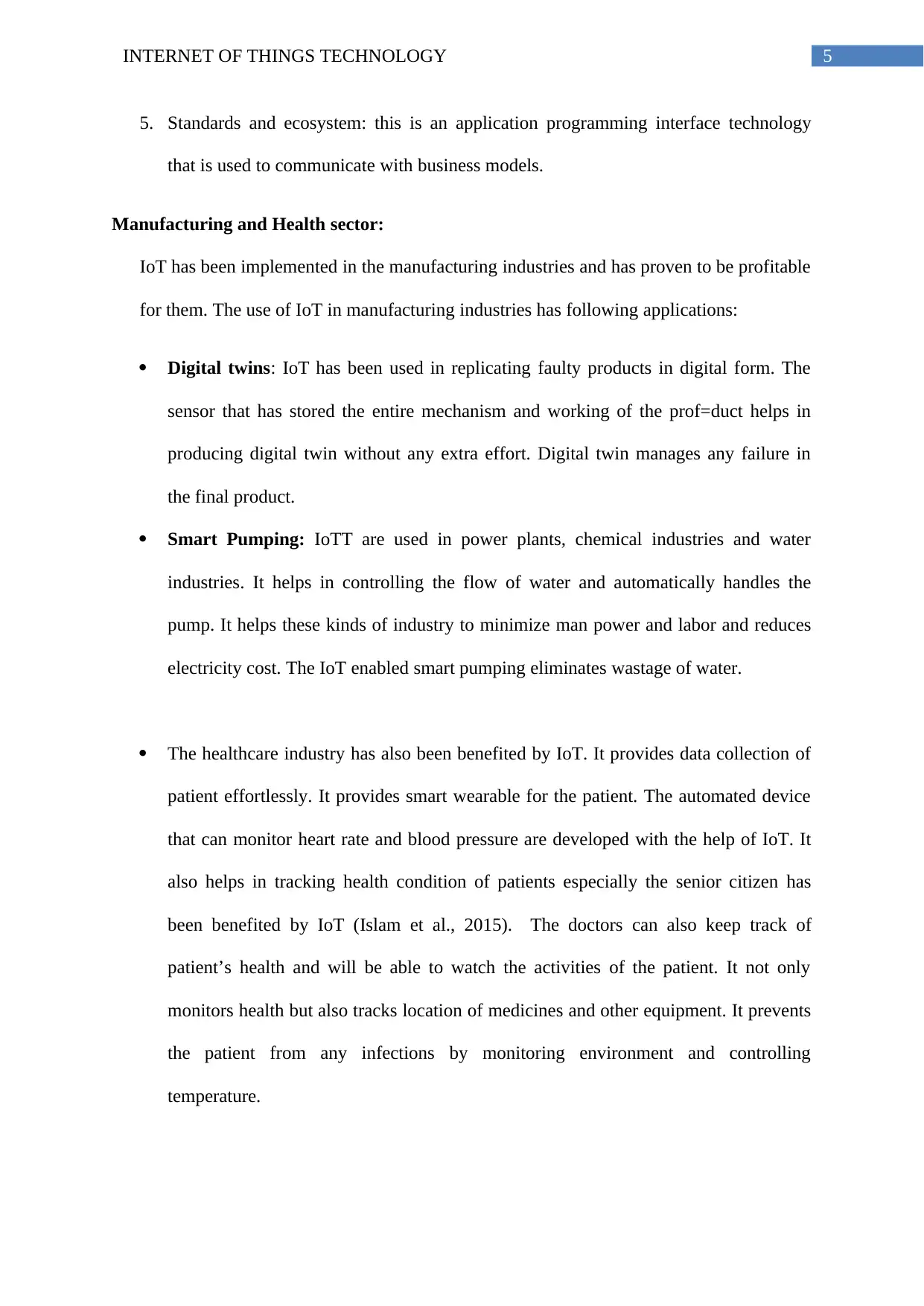
5INTERNET OF THINGS TECHNOLOGY
5. Standards and ecosystem: this is an application programming interface technology
that is used to communicate with business models.
Manufacturing and Health sector:
IoT has been implemented in the manufacturing industries and has proven to be profitable
for them. The use of IoT in manufacturing industries has following applications:
Digital twins: IoT has been used in replicating faulty products in digital form. The
sensor that has stored the entire mechanism and working of the prof=duct helps in
producing digital twin without any extra effort. Digital twin manages any failure in
the final product.
Smart Pumping: IoTT are used in power plants, chemical industries and water
industries. It helps in controlling the flow of water and automatically handles the
pump. It helps these kinds of industry to minimize man power and labor and reduces
electricity cost. The IoT enabled smart pumping eliminates wastage of water.
The healthcare industry has also been benefited by IoT. It provides data collection of
patient effortlessly. It provides smart wearable for the patient. The automated device
that can monitor heart rate and blood pressure are developed with the help of IoT. It
also helps in tracking health condition of patients especially the senior citizen has
been benefited by IoT (Islam et al., 2015). The doctors can also keep track of
patient’s health and will be able to watch the activities of the patient. It not only
monitors health but also tracks location of medicines and other equipment. It prevents
the patient from any infections by monitoring environment and controlling
temperature.
5. Standards and ecosystem: this is an application programming interface technology
that is used to communicate with business models.
Manufacturing and Health sector:
IoT has been implemented in the manufacturing industries and has proven to be profitable
for them. The use of IoT in manufacturing industries has following applications:
Digital twins: IoT has been used in replicating faulty products in digital form. The
sensor that has stored the entire mechanism and working of the prof=duct helps in
producing digital twin without any extra effort. Digital twin manages any failure in
the final product.
Smart Pumping: IoTT are used in power plants, chemical industries and water
industries. It helps in controlling the flow of water and automatically handles the
pump. It helps these kinds of industry to minimize man power and labor and reduces
electricity cost. The IoT enabled smart pumping eliminates wastage of water.
The healthcare industry has also been benefited by IoT. It provides data collection of
patient effortlessly. It provides smart wearable for the patient. The automated device
that can monitor heart rate and blood pressure are developed with the help of IoT. It
also helps in tracking health condition of patients especially the senior citizen has
been benefited by IoT (Islam et al., 2015). The doctors can also keep track of
patient’s health and will be able to watch the activities of the patient. It not only
monitors health but also tracks location of medicines and other equipment. It prevents
the patient from any infections by monitoring environment and controlling
temperature.
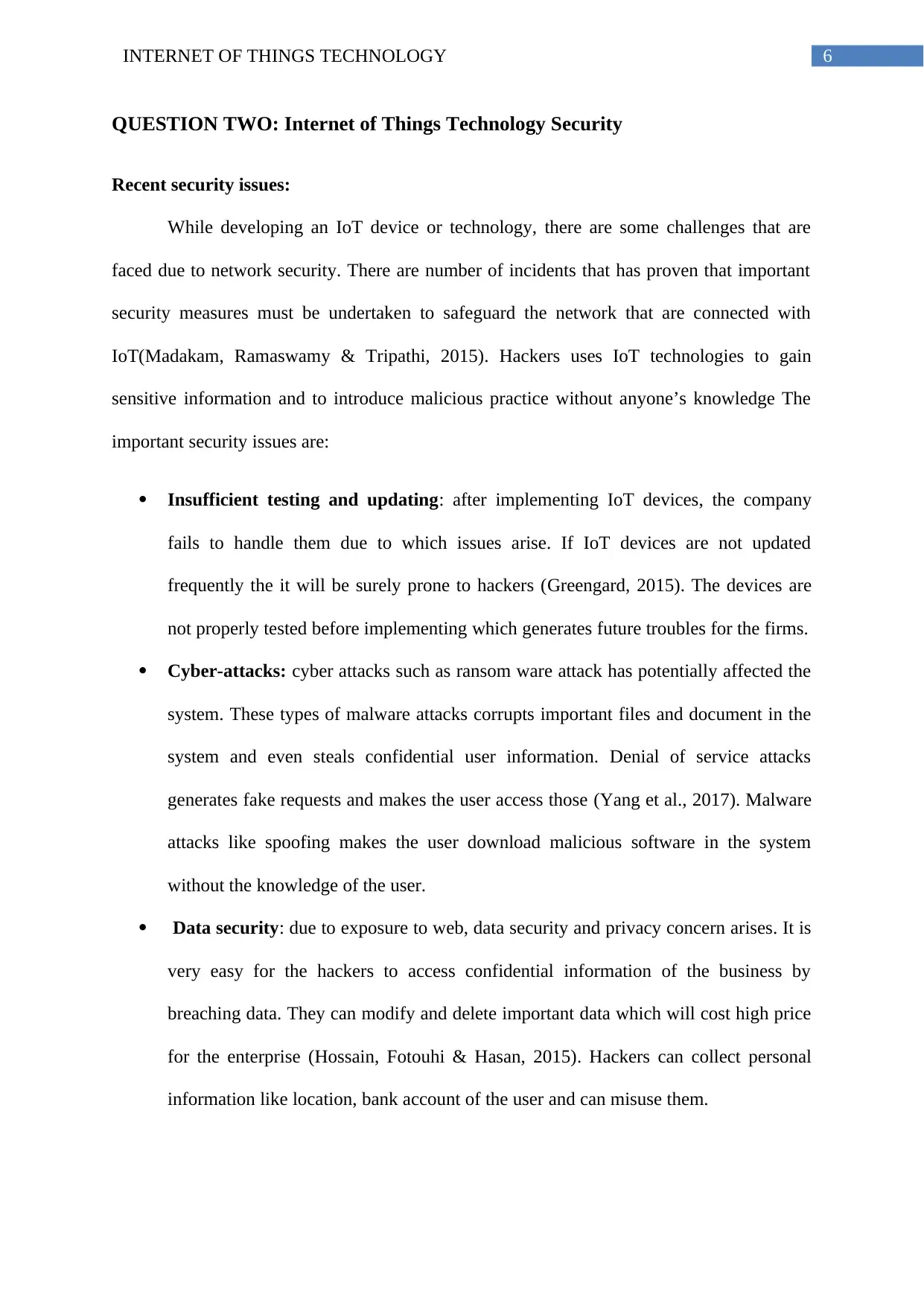
6INTERNET OF THINGS TECHNOLOGY
QUESTION TWO: Internet of Things Technology Security
Recent security issues:
While developing an IoT device or technology, there are some challenges that are
faced due to network security. There are number of incidents that has proven that important
security measures must be undertaken to safeguard the network that are connected with
IoT(Madakam, Ramaswamy & Tripathi, 2015). Hackers uses IoT technologies to gain
sensitive information and to introduce malicious practice without anyone’s knowledge The
important security issues are:
Insufficient testing and updating: after implementing IoT devices, the company
fails to handle them due to which issues arise. If IoT devices are not updated
frequently the it will be surely prone to hackers (Greengard, 2015). The devices are
not properly tested before implementing which generates future troubles for the firms.
Cyber-attacks: cyber attacks such as ransom ware attack has potentially affected the
system. These types of malware attacks corrupts important files and document in the
system and even steals confidential user information. Denial of service attacks
generates fake requests and makes the user access those (Yang et al., 2017). Malware
attacks like spoofing makes the user download malicious software in the system
without the knowledge of the user.
Data security: due to exposure to web, data security and privacy concern arises. It is
very easy for the hackers to access confidential information of the business by
breaching data. They can modify and delete important data which will cost high price
for the enterprise (Hossain, Fotouhi & Hasan, 2015). Hackers can collect personal
information like location, bank account of the user and can misuse them.
QUESTION TWO: Internet of Things Technology Security
Recent security issues:
While developing an IoT device or technology, there are some challenges that are
faced due to network security. There are number of incidents that has proven that important
security measures must be undertaken to safeguard the network that are connected with
IoT(Madakam, Ramaswamy & Tripathi, 2015). Hackers uses IoT technologies to gain
sensitive information and to introduce malicious practice without anyone’s knowledge The
important security issues are:
Insufficient testing and updating: after implementing IoT devices, the company
fails to handle them due to which issues arise. If IoT devices are not updated
frequently the it will be surely prone to hackers (Greengard, 2015). The devices are
not properly tested before implementing which generates future troubles for the firms.
Cyber-attacks: cyber attacks such as ransom ware attack has potentially affected the
system. These types of malware attacks corrupts important files and document in the
system and even steals confidential user information. Denial of service attacks
generates fake requests and makes the user access those (Yang et al., 2017). Malware
attacks like spoofing makes the user download malicious software in the system
without the knowledge of the user.
Data security: due to exposure to web, data security and privacy concern arises. It is
very easy for the hackers to access confidential information of the business by
breaching data. They can modify and delete important data which will cost high price
for the enterprise (Hossain, Fotouhi & Hasan, 2015). Hackers can collect personal
information like location, bank account of the user and can misuse them.
Paraphrase This Document
Need a fresh take? Get an instant paraphrase of this document with our AI Paraphraser

7INTERNET OF THINGS TECHNOLOGY
Service interruption: there can be massive interruption while data transmission like
loss of network and support of cloud. The devices might get damaged or stolen. Loss
in connection, error in cloud, disrupted Wi-Fi and many more can be major issues
while implementing IoT.
Resolution of security issues:
Data securing: The important application of IoT devices is to collect valuable data
information. These data are needed to be protected from any malicious attack. By
using Secure Socket Layer (SSL), data can be encrypted and will preserve its
appearance online. Sensitive data must be encrypted while transferring data (Sicari et
al., 2015). In order to protect sensitive information, one must keep on updating its
default password. The IoT devices must collect limited data that is required for the
operation. It will help in eliminating the risk of data leakage. By restricting the
communication of network will also help in providing better security. The
implementation of firewall in network will also reduce data breach.
Secure devices: The IoT devices must be secured first is that it does not gets thefted.
By making the devices tamper resistant and using port locks will add physical security
to the devices. The devices must be updated constantly in order to ensure the security
of the devices. Testing and static code is the best method to detect any fault in the
devices. By implementing complicated codes, the data will be secured. By using
cryptographic keys, data authentication method can be performed.
Network securing: The network can be secured by cryptographic algorithms to IoT
devices. TLS can be used to optimize these devices. The execution of security
analytics has reduced the security issues drastically.
Service interruption: there can be massive interruption while data transmission like
loss of network and support of cloud. The devices might get damaged or stolen. Loss
in connection, error in cloud, disrupted Wi-Fi and many more can be major issues
while implementing IoT.
Resolution of security issues:
Data securing: The important application of IoT devices is to collect valuable data
information. These data are needed to be protected from any malicious attack. By
using Secure Socket Layer (SSL), data can be encrypted and will preserve its
appearance online. Sensitive data must be encrypted while transferring data (Sicari et
al., 2015). In order to protect sensitive information, one must keep on updating its
default password. The IoT devices must collect limited data that is required for the
operation. It will help in eliminating the risk of data leakage. By restricting the
communication of network will also help in providing better security. The
implementation of firewall in network will also reduce data breach.
Secure devices: The IoT devices must be secured first is that it does not gets thefted.
By making the devices tamper resistant and using port locks will add physical security
to the devices. The devices must be updated constantly in order to ensure the security
of the devices. Testing and static code is the best method to detect any fault in the
devices. By implementing complicated codes, the data will be secured. By using
cryptographic keys, data authentication method can be performed.
Network securing: The network can be secured by cryptographic algorithms to IoT
devices. TLS can be used to optimize these devices. The execution of security
analytics has reduced the security issues drastically.
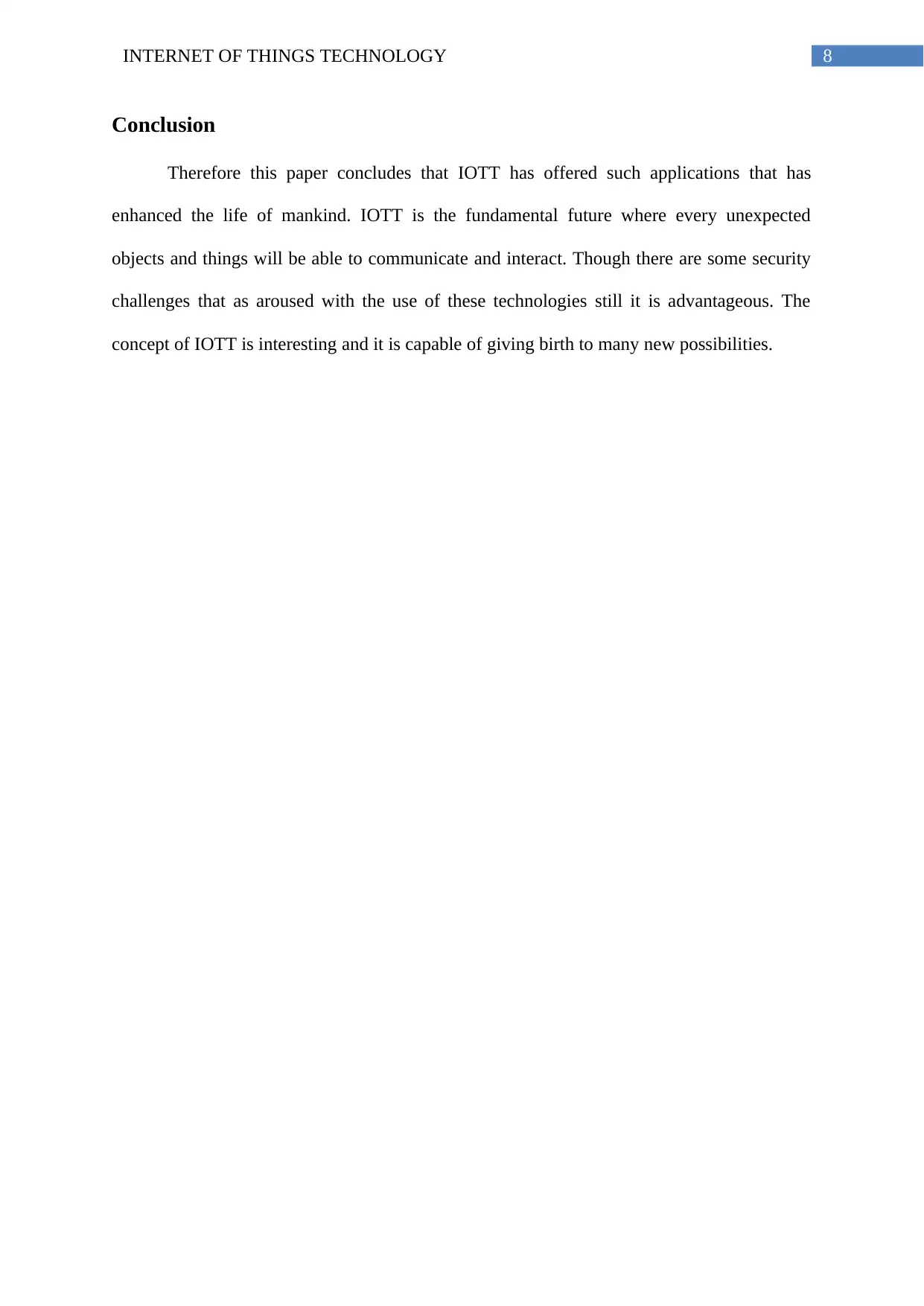
8INTERNET OF THINGS TECHNOLOGY
Conclusion
Therefore this paper concludes that IOTT has offered such applications that has
enhanced the life of mankind. IOTT is the fundamental future where every unexpected
objects and things will be able to communicate and interact. Though there are some security
challenges that as aroused with the use of these technologies still it is advantageous. The
concept of IOTT is interesting and it is capable of giving birth to many new possibilities.
Conclusion
Therefore this paper concludes that IOTT has offered such applications that has
enhanced the life of mankind. IOTT is the fundamental future where every unexpected
objects and things will be able to communicate and interact. Though there are some security
challenges that as aroused with the use of these technologies still it is advantageous. The
concept of IOTT is interesting and it is capable of giving birth to many new possibilities.
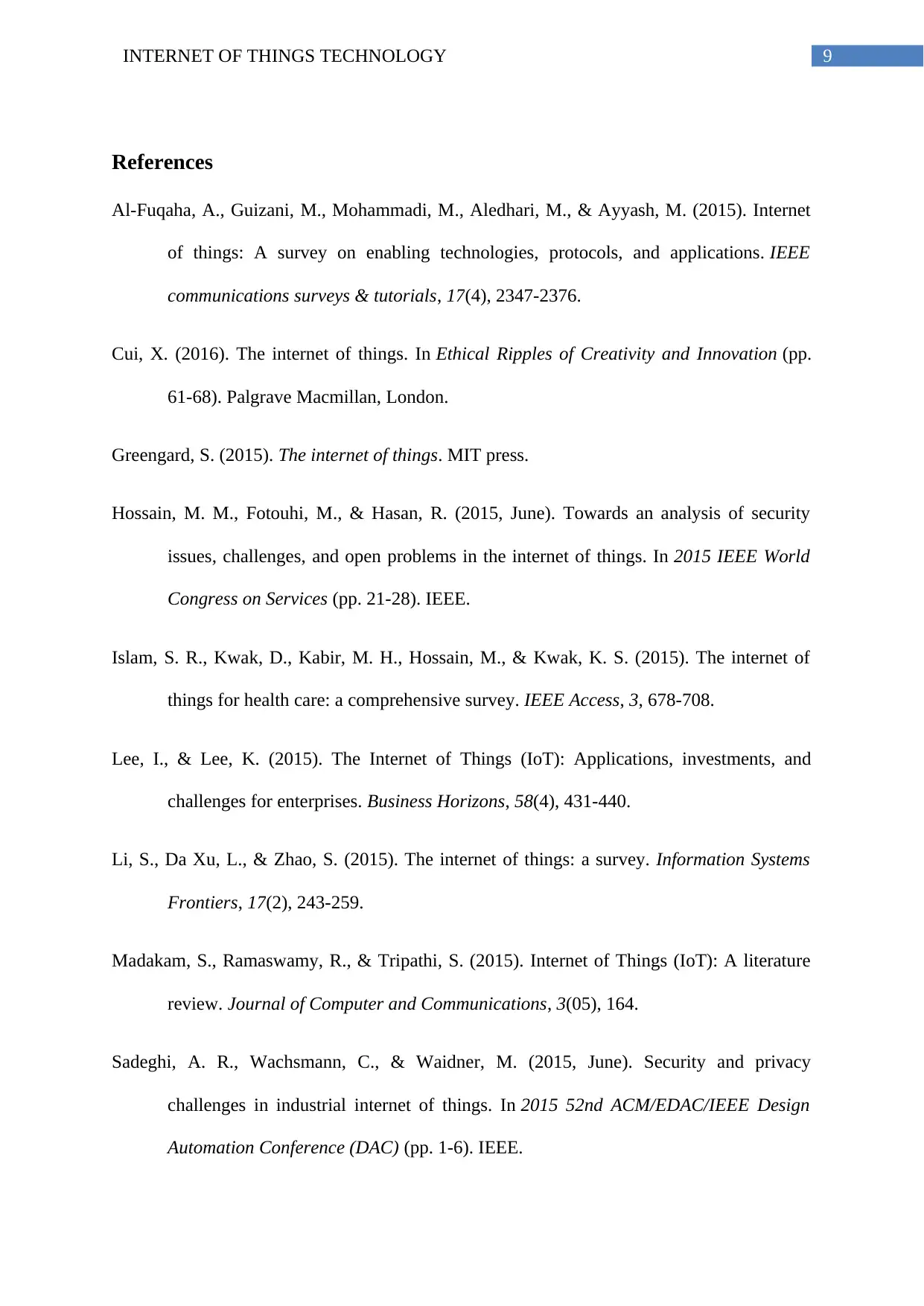
9INTERNET OF THINGS TECHNOLOGY
References
Al-Fuqaha, A., Guizani, M., Mohammadi, M., Aledhari, M., & Ayyash, M. (2015). Internet
of things: A survey on enabling technologies, protocols, and applications. IEEE
communications surveys & tutorials, 17(4), 2347-2376.
Cui, X. (2016). The internet of things. In Ethical Ripples of Creativity and Innovation (pp.
61-68). Palgrave Macmillan, London.
Greengard, S. (2015). The internet of things. MIT press.
Hossain, M. M., Fotouhi, M., & Hasan, R. (2015, June). Towards an analysis of security
issues, challenges, and open problems in the internet of things. In 2015 IEEE World
Congress on Services (pp. 21-28). IEEE.
Islam, S. R., Kwak, D., Kabir, M. H., Hossain, M., & Kwak, K. S. (2015). The internet of
things for health care: a comprehensive survey. IEEE Access, 3, 678-708.
Lee, I., & Lee, K. (2015). The Internet of Things (IoT): Applications, investments, and
challenges for enterprises. Business Horizons, 58(4), 431-440.
Li, S., Da Xu, L., & Zhao, S. (2015). The internet of things: a survey. Information Systems
Frontiers, 17(2), 243-259.
Madakam, S., Ramaswamy, R., & Tripathi, S. (2015). Internet of Things (IoT): A literature
review. Journal of Computer and Communications, 3(05), 164.
Sadeghi, A. R., Wachsmann, C., & Waidner, M. (2015, June). Security and privacy
challenges in industrial internet of things. In 2015 52nd ACM/EDAC/IEEE Design
Automation Conference (DAC) (pp. 1-6). IEEE.
References
Al-Fuqaha, A., Guizani, M., Mohammadi, M., Aledhari, M., & Ayyash, M. (2015). Internet
of things: A survey on enabling technologies, protocols, and applications. IEEE
communications surveys & tutorials, 17(4), 2347-2376.
Cui, X. (2016). The internet of things. In Ethical Ripples of Creativity and Innovation (pp.
61-68). Palgrave Macmillan, London.
Greengard, S. (2015). The internet of things. MIT press.
Hossain, M. M., Fotouhi, M., & Hasan, R. (2015, June). Towards an analysis of security
issues, challenges, and open problems in the internet of things. In 2015 IEEE World
Congress on Services (pp. 21-28). IEEE.
Islam, S. R., Kwak, D., Kabir, M. H., Hossain, M., & Kwak, K. S. (2015). The internet of
things for health care: a comprehensive survey. IEEE Access, 3, 678-708.
Lee, I., & Lee, K. (2015). The Internet of Things (IoT): Applications, investments, and
challenges for enterprises. Business Horizons, 58(4), 431-440.
Li, S., Da Xu, L., & Zhao, S. (2015). The internet of things: a survey. Information Systems
Frontiers, 17(2), 243-259.
Madakam, S., Ramaswamy, R., & Tripathi, S. (2015). Internet of Things (IoT): A literature
review. Journal of Computer and Communications, 3(05), 164.
Sadeghi, A. R., Wachsmann, C., & Waidner, M. (2015, June). Security and privacy
challenges in industrial internet of things. In 2015 52nd ACM/EDAC/IEEE Design
Automation Conference (DAC) (pp. 1-6). IEEE.
Secure Best Marks with AI Grader
Need help grading? Try our AI Grader for instant feedback on your assignments.
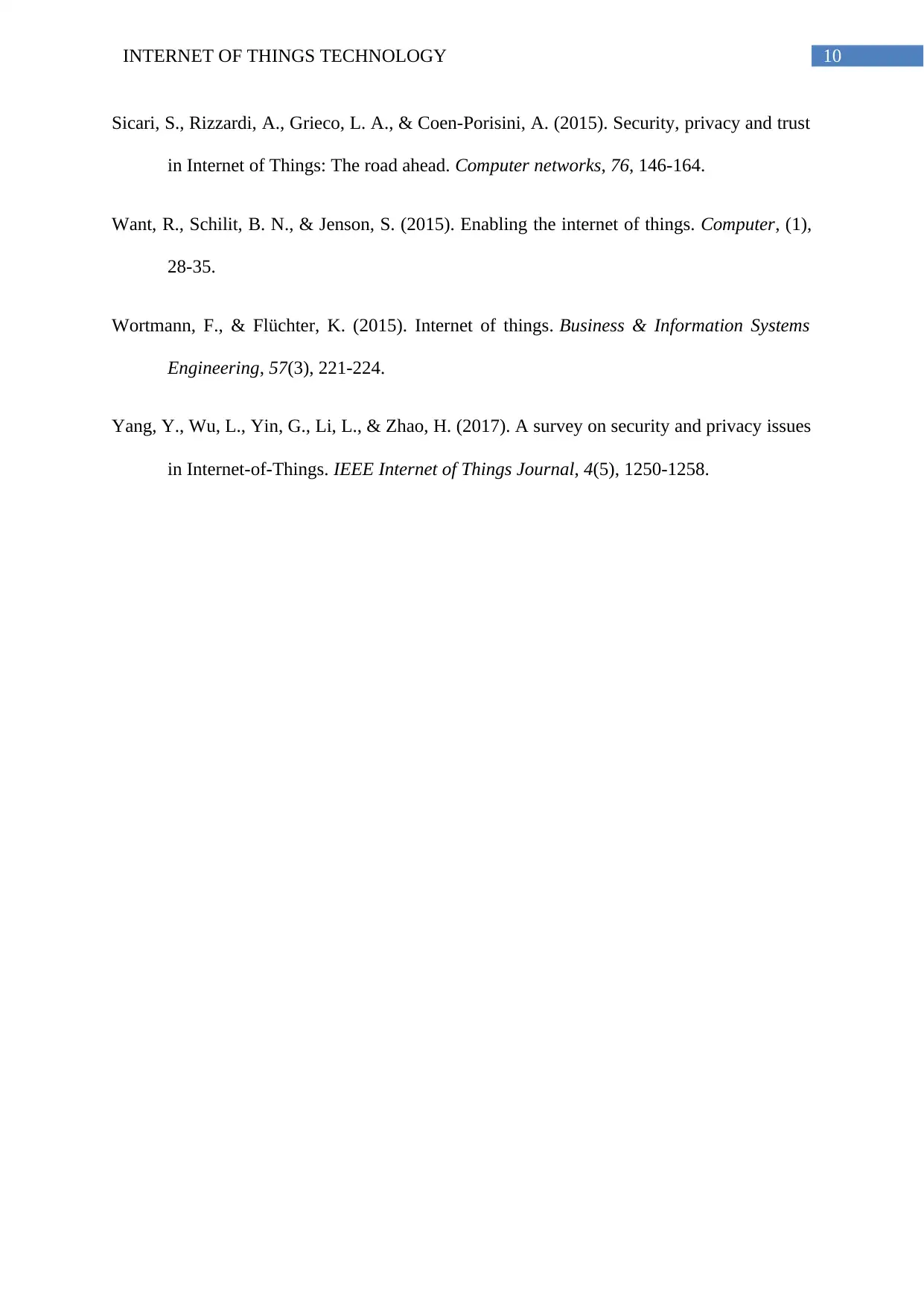
10INTERNET OF THINGS TECHNOLOGY
Sicari, S., Rizzardi, A., Grieco, L. A., & Coen-Porisini, A. (2015). Security, privacy and trust
in Internet of Things: The road ahead. Computer networks, 76, 146-164.
Want, R., Schilit, B. N., & Jenson, S. (2015). Enabling the internet of things. Computer, (1),
28-35.
Wortmann, F., & Flüchter, K. (2015). Internet of things. Business & Information Systems
Engineering, 57(3), 221-224.
Yang, Y., Wu, L., Yin, G., Li, L., & Zhao, H. (2017). A survey on security and privacy issues
in Internet-of-Things. IEEE Internet of Things Journal, 4(5), 1250-1258.
Sicari, S., Rizzardi, A., Grieco, L. A., & Coen-Porisini, A. (2015). Security, privacy and trust
in Internet of Things: The road ahead. Computer networks, 76, 146-164.
Want, R., Schilit, B. N., & Jenson, S. (2015). Enabling the internet of things. Computer, (1),
28-35.
Wortmann, F., & Flüchter, K. (2015). Internet of things. Business & Information Systems
Engineering, 57(3), 221-224.
Yang, Y., Wu, L., Yin, G., Li, L., & Zhao, H. (2017). A survey on security and privacy issues
in Internet-of-Things. IEEE Internet of Things Journal, 4(5), 1250-1258.
1 out of 11
Related Documents
Your All-in-One AI-Powered Toolkit for Academic Success.
+13062052269
info@desklib.com
Available 24*7 on WhatsApp / Email
![[object Object]](/_next/static/media/star-bottom.7253800d.svg)
Unlock your academic potential
© 2024 | Zucol Services PVT LTD | All rights reserved.





